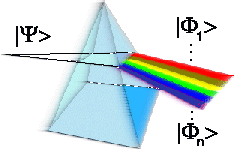Phys. Rev. B 66, 165418 (2002)
Magdalena A. Załuska-Kotur, Zbigniew W. Gortel, and Robert Teshima
Atomic migration within the organized oxygen overlayers on the basal plane of Ru(001) is modeled within phenomenological mesoscopic model accounting for all possible atomic jumps within the adsorbate and capable of accessing several time scales in the migration kinetics. Experimentally observed diffusion and trapping of the isolated oxygen vacancy within the 3O(2×2) overlayer at coverage θ=3/4 are accounted for. The comparison with experiment is used to propose values of parameters for interactions between an atom adsorbed at a hcp site and another one temporarily at some of the neighboring bridge sites. The modeling is extended to the O(2×2) overlayer at θ=1/4 and it is shown that for this structure a competing diffusion channel exists which breaks down the equivalence of the atomic migration behavior between the organized θ=1/4 and θ=3/4 overlayers. For both overlayers simplified effective models are formulated, free of unobservable metastable configurations and unobservable time scales. Considerations for the ideal O(2×1) rowlike overlayer at θ=1/2 confirm that occasional jumps of the oxygen atoms to one side of the rows should be observable in the STM images for this overlayer in contrast to the θ=1/4 and 3/4 overlayers for which an excess atom or a vacancy, respectively, are necessary to initiate observable atomic migration processes.
Aug 5, 2002
Graphical examples of geometrical and wave optics
Władysław Żakowicz
A simple method of the description of optical pulses of finite dimensions and finite duration time is presented. The pulses are given by superpositions of the known analytical as well as numerical solutions of the Maxwell equations. The examples show optical properties of scattering in detail. In the general case the wide pulses split in the scattering processes. The description of these phenomena requires a full wave approach. The pulses (or their fragments) that do not split but move smoothly through the optical system (or its fragment) may be described with the help of the geometrical optics theory.
Acta Phys. Polon. B 33, 2059 (2002)
A simple method of the description of optical pulses of finite dimensions and finite duration time is presented. The pulses are given by superpositions of the known analytical as well as numerical solutions of the Maxwell equations. The examples show optical properties of scattering in detail. In the general case the wide pulses split in the scattering processes. The description of these phenomena requires a full wave approach. The pulses (or their fragments) that do not split but move smoothly through the optical system (or its fragment) may be described with the help of the geometrical optics theory.
Acta Phys. Polon. B 33, 2059 (2002)
Subscribe to:
Comments (Atom)
